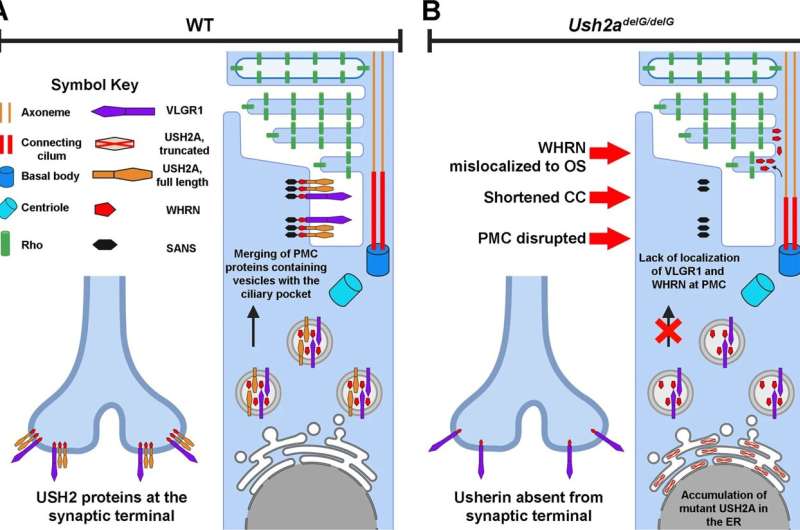This article has been reviewed according to Science X's editorial process and policies. Editors have highlighted the following attributes while ensuring the content's credibility:
fact-checked
peer-reviewed publication
trusted source
proofread
Researcher builds new model to examine Usher syndrome

Usher syndrome, a rare inherited genetic disease, is a leading cause of combined deafness and blindness with type 2A (USH2A) being the most common form. USH2A, caused by mutations in the USH2A gene, can include hearing loss from birth and progressive loss of vision, prompting retinitis pigmentosa (RP). RP affects the retina, the eye's light-sensitive layer, leading to a breakdown of the light-sensitive cells in the retina which initially leads to night blindness followed by progressive loss of daily vision. Currently no treatment exists for USH2A.
Also, no study has come close to examining the actual mechanics behind the illness, until now—even though establishing a model for USH2A that mirrors patient's phenotypes has been an important goal for the future development of therapeutic strategies. Most Usher syndrome models successfully reproduce the hearing loss observed in patients but fail to model the visual problems.
"In our study, published in Nature Communications, we designed and generated a model expressing c.2299delG, the most common human disease mutation in USH2A," reports Muna Naash, John S. Dunn Endowed Professor of Biomedical Engineering.
"The model exhibits retinal degeneration and expresses a truncated, glycosylated protein which is mislocalized to the photoreceptor inner segment. The degeneration is associated with a decline in retinal function, structural abnormalities in connecting cilium and outer segment and mislocalization of the usherin interacting partners—very long G-protein receptor 1 (VLGR1) and whirlin (WHRN)."
Those results prove that expression of the actual mutant protein is beneficial in reproducing USH2A retinal phenotype and offers insight into strategies for designing therapeutic interventions.
An in-depth analysis of the retina in the model revealed structural anomalies in the photoreceptors ultimately leading to the death of the photoreceptor cells causing vision loss. Because the model closely mimics the disease it will allow Naash to study the mechanism of the disease and investigate options for treatment including gene therapy.
"Our model exhibits retinal degeneration associated with a decline in retinal function and continues to support the development of an effective gene therapy platform to treat USH2A associated visual defects," said Naash.
Others on the Naash team at UH include Muayyad R. Al-Ubaidi, Moores Professor of biomedical engineering; Lars Tebbe, assistant professor of research; Mustafa Makia and three students recently graduated: Maggie Mwoyosvi, Ryan Crane and Mashal Kakakhel.
More information: Lars Tebbe et al, The usherin mutation c.2299delG leads to its mislocalization and disrupts interactions with whirlin and VLGR1, Nature Communications (2023). DOI: 10.1038/s41467-023-36431-1


















